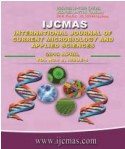


 National Academy of Agricultural Sciences (NAAS)
National Academy of Agricultural Sciences (NAAS)

|
PRINT ISSN : 2319-7692
Online ISSN : 2319-7706 Issues : 12 per year Publisher : Excellent Publishers Email : editorijcmas@gmail.com / submit@ijcmas.com Editor-in-chief: Dr.M.Prakash Index Copernicus ICV 2018: 95.39 NAAS RATING 2020: 5.38 |
Urinary tract infections (UTI) are the second most common infections encountered in clinical practice and is associated with a high rate of morbidity and economic burden. Knowledge of the local antibiotic resistance patterns will help in providing empirical therapy and helps in prevention of resistance. This was a retrospective study conducted from January 2017 to December 2018 at a medical college in South India. Samples received included mid-stream clean catch urine, Catheterized urine, suprapubic aspirate. Urine specimen was collected in a sterile, wide mouth, leak proof, labelled container. Urine was processed immediately within one hour without delay. Samples were processed and isolates were identified as per standard methods. Antibiotic sensitivity testing was done on Mueller Hinton agar by Kirby–Bauer disc diffusion method and CLSI guidelines. Most UTI cases were seen in females and in the age group of 31-40 years. The most common organism isolated was E. coli (64.4%), followed by Klebsiella species (9.9%) and Pseudomonas aeruginosa (7.4%). The most common Gram-positive organism was Staphylococcus aureus (5.9%). Highest resistance was seen with Ampicillin (98%) and Amoxicillin-clavulanic acid (74%) and least resistance was seen with Imipenem and Piperacillin-Tazobactam. The inappropriate and irrational empirical use of antibiotics (particularly wide spectrum antibiotics), immuno-suppression, prolonged stay (catherization) are some of the major reasons responsible for resistant urinary tract infections. The present study revealed that urinary tract infections caused by E. coli was resistant to commonly used antibiotics. On the basis of local antibiotic susceptibility pattern, Nitrofurantoin (oral) and Amikacin (parenteral) can be used as first line empiric therapy for treatment of UTI. A major intervention in preventing resistant UTI is the regular monitoring of antibiotic resistance pattern which helps in initiating empirical treatment of UTI and definitive therapy must be initiated only after culture sensitivity report. As the antibiotic resistance pattern changes over a period of time, regular antibiotic susceptibility pattern studies should be conducted region wise.
 |
 |
 |
 |
 |